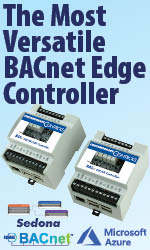BACnet In Public Administration Buildings
Lowering Energy Consumption While Maximizing Comfort

Salvatore Cataldi
ESAC
|
November 2010 |
Innovations in Comfort, Efficiency, and Safety Solutions. |
BACnet In Public Administration BuildingsLowering Energy Consumption While Maximizing Comfort |
 Salvatore Cataldi ESAC |
The best
way to save money is to keep systems switched off. We would achieve an
unbelievable energy surplus, but who of us can work in an office with stale air,
no conditioning and no lighting?
 |
 |
 |
 |
 |
 |
 |
 |
 |
 |
 |
 |
 |
|
|
Talking
about the place we work, the goal is always to achieve the best “compromise”
between comfort and energy consumption. The process that finds this
“compromise” is system controlling.
ESAC,
a BACnet System Integrator in
“Simple is
better”: this motto is always true. The challenge was to reduce energy
consumption in many different buildings keeping a good comfort level. In approaching
such a complex problem, it is of great help and a good experimental method, to
break down the big one into small and simple problems and then face them in a common,
simple way.
If the goal
is to reduce energy consumption, then we need to accurately know how much
energy our systems consume. Once we’ve got the figures, we need to accurately
analyze and deeply understand them, this is important to determine what is
convenient to control. Then it is important to operate in a sharp and prompt
way.
In the
building life-cycle these three steps: metering, analysis and control run
continuously one after the other and they change as the building's internal or
external situation changes.
First
we set up the experimental method and following the same method; we found BACnet
to be the best integration platform. The ISO 16484-5 (BACnet) standard, more
than offering real interoperability among devices from different producers, is
based on an extremely scalable system design that allows our small and simple
solutions to be interconnected in a much more complex system scattered over the
region.
ISO 16484-3
standard describes building automation logic functions and BACnet (ISO 16484-5)
represents those functionalities under the information technology point of
view. ISO 15232 “Energy performance of buildings - Impact of
Building Automation, Controls and Building Management” refers to ISO 16484-
It is evident that BACnet can be considered not only as a communication
protocol or an integration platform but also as a point of convergence for
different systems within the building. So why we should reinvent the wheel?
The
research activity lasted for several months covering from winter 2009 to summer
2010. The building had a Daikin VRV air conditioning system with 263 internal
units - almost one in each office, a chiller and a small boiler room serving three
AHU for a total air inlet of
These four HVAC
systems were “BACnet networkable” and so for our research activity a B-OWS,
ORCAWeb from Delta Controls, was setup to store collected data in a
relational database and to publish on the Internet a web site with consumption
details and an integrated control interface.
Optimizing
energy savings in relation to comfort level was the goal of our research.
How the
comfort level feels to the people working in the building was measured by
weekly questionnaires. At the same time the temperature in every single office, and
the power and thermal energy consumption for each system component was measured
and stored in a relational database.
Data
analysis and comparison was made through the B-OWS web interface from where the
operator was able to setup a new set of parameters for the coming week.
The three
steps of metering, analysis and control were there, and brought us good results.
Having direct feedback
from users working everyday in the building gave us the opportunity to
fine tune the system with automatic logic that sees the
interaction of outside temperature, building thermic lag and efficient
scheduling. User satisfaction was so achieved.
Energy
saving goals have been evaluated in terms of savings of electricity consumption.
During winter and summer this reduction has been an average of 30% of cost
savings compared to the previous operation.
This result
is coherent with ISO 15232, that forecast a maximum level of savings of 39%
for automation systems within office buildings. At the same time this result is
equivalent to what the BOMA (Building Owners and Managers Association)
foretells: a potential energy consumption reduction by 30% by means of automation
processes similar to the ones implemented in our research.
As a follow up to its development, this project will be continuously implemented on the same
building but not only for energy consumption reduction. Collecting data for a longer
time will be a base for systems efficiency compared analysis during their
life-cycle. This is the next goal for this project within the original
building; to automatically understand if and when a system is going out of its
normal operation parameter or if there is an efficiency reduction.
This will be
implemented not only for electric power consumption but also for natural gas
consumption.
 All the concepts
and strategies developed during the research period can be applied to all the
different buildings of the Piedmont regional administration. There is an IP
network connecting all the regional office building in a Wan. A BACnet network
has been designed on this IP network infrastructure. On old plants, BACnet
freely programmable controllers will be used for data collecting and boiler
room control. Modern plants, already with BACnet interfaces, will be directly
connected to the network by means of BACnet routers where needed.
All the concepts
and strategies developed during the research period can be applied to all the
different buildings of the Piedmont regional administration. There is an IP
network connecting all the regional office building in a Wan. A BACnet network
has been designed on this IP network infrastructure. On old plants, BACnet
freely programmable controllers will be used for data collecting and boiler
room control. Modern plants, already with BACnet interfaces, will be directly
connected to the network by means of BACnet routers where needed.
Thanks to
the BACnet scalable design the whole system will be smooth and the cost of new
extensions predictable.
Moreover,
having all the sites connected in an single system it will be simpler to
develop a performance analysis all over the region, gathering a much richer set of information.
The analysis
of this information and the capability of accurate control on every
different site, in addition to the advantages described in the BComfort
project, will lead to new goals coming from new opportunities for energy savings.
The HVAC
system is the first of the two different kinds of systems demanding the most of
the energy consumed by a building, the lighting system is the second.
Within the
same building as the BComfort project, a new research activity is about to
start to reduce the energy consumption of lighting for every single office while keeping the standards of comfort high.
Implementing
motion detection and day-lighting strategies, a system with an integrated web
services based dashboard will be in the hands of the facility manager. This new
system will be implemented on the same network infrastructure built for the
BComfort project.
Through this
interface it will be possible to set up lighting behaviours for each single
office. Important energy savings are again predictable.
The next
step will be the integration of different systems such as air conditioning
and lighting, to fully exploit interoperability by implementing different
comfort scenarios (out of service, stand-by, comfort) controlling temperatures,
and lighting according to the actual occupancy of the office.
We discovered that implementing an open standard such as BACnet at every automation level, from the meter to the operator dashboard, gave us an enormous capability for data collecting, analysis and control. In simple words a powerful tool to let us focus on actual independent system optimization. And this is what we’re going to do next.
About the Author
General Manger at ESAC srl, Torino, Italy -
http://www.esacsrl.com
Active member of the WG-T in the BACnet Interest Group
Europe, Salvatore has been working since 1995 as a professional consultant for
different companies in the development of internet distributed systems for
telemetry, multimedia services, process and production control and energy
management. Author of several publications on system integration for building
automation through open and standard software media, in 2004, with other
associated engineers, he founded ESAC company to bring ICT experience to the
building automation field. Ever since its foundation, ESAC has been a System
Integrator adopting BACnet as the integration platform where every sub-system
in the building converges. ESAC, in the last years, started producing gateway
solutions, developed for its own BMS first, as independent engineered products.
Salvatore can be reached at bacnet@esacsrl.com
[Home Page] [The Automator] [About] [Subscribe ] [Contact Us]